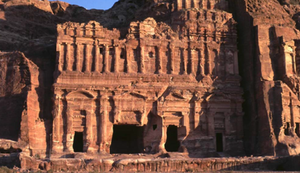‘Petra Palace Tomb’ (UNESCO)
The Department for the Geological Survey of Italy has been supporting since 2009 the UNESCO Amman Office and the Department of Antiquities of Jordan (DOA) for the geological conservation of the UNESCO site of Petra. The Petra Archaeological Park (PAP), a UNESCO World Heritage site since 1985, is characterized by a spectacular landscape but also by a great fragility fragile being prone to a diversity of natural risks (e.g. landslides, flash-floods, earthquakes) which can cause a potential danger to cultural heritage and visitors. The Palace Tomb is part of the monumental complex of the Royal Tombs of Petra which represent a remarkable example of Nabataean rupestrian architecture. Built between the 1st and 2nd century AD, this imposing monument is in danger due to climate-driven factors (i.e. erosion of the façade caused by wind erosion and water runoff, salts formation) and high vulnerability due to geological causes (earthquakes, slope instability) enhanced by the presence of persistent cracks in the sandstone rock-hewn monument.
The UNESCO ‘Palace Tomb’ project, funded by AICS – Italian Agency for Development Cooperation, aims at ensuring its long-term conservation by applying a comprehensive preventive approach which incorporates archaeological and engineering geological methods and in line with the conservation policies identified as part of the Petra Integrated Management Plan.

